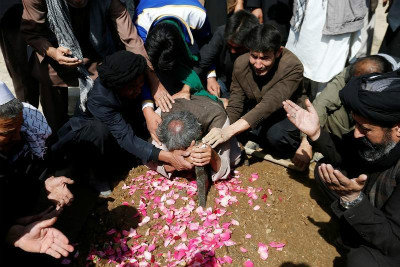By Ahmad Shuja

Afghan Shi'ite Muslims men mourn over the grave of a victim who was killed in an attack at the Sakhi Shrine in Kabul, Afghanistan October 12, 2016. (Photo: Reuters)
A gunman wearing an Afghan National Security Forces uniform opened fire on Shia mourners at Kabul’s landmark Sakhi Shrine on Wednesday, killing 18 people and wounding 54. The attack on members of the Shia Hazara community occurred on the eve of Ashura, the Shia mourning day. Victims included four women, including Sumaya Muhammadi, a member of the Daikundi provincial council, and two children. The Islamic State, also known as ISIS, claimed responsibility for the attack.
The Shia Hazara community’s agonies didn’t end on the eve of Ashura. The following morning, a blast from an improvised explosive device (IED) killed at least 15 Hazaras in Afghanistan’s northern Balkh province. ISIS claimed responsibility for this attack, too, its third on the country’s Hazara community since the July 23 bombing of a peaceful protest in Kabul that left more than 85 dead and 400 wounded.
The security environment is worsening for all Afghans in the face of an intensifying insurgency. However, these targeted attacks on Shia Hazaras underscore their increasing vulnerability, even in big cities under firm government control. Over the past three years, insurgents have specifically targeted Hazaras traveling on rural roads for kidnap or killing.
Afghanistan already has a grim history of killings targeting the Hazara community. The Ashura attacks brought back chilling memories of the house-to-house searches by the Taliban in 1998 to identify and kill Hazaras in the northern province of Balkh. The killing spree, which followed speeches by the Taliban governor demanding that Hazaras convert to Sunni Islam, left thousands dead.
The plight of Shia Hazaras in neighboring Pakistan offers a grim lesson of what might happen if the Afghan government fails to protect vulnerable minorities. Pakistan’s besieged Hazara communities have faced a bloody onslaught by the extremist anti-Shia militant group Lashkar-e Jhangvi for more than a decade in the face of official indifference, or worse, government complicity. Lashkar-e Jhangvi has already sought to export its trademark targeting of large religious gatherings to Afghanistan in 2011, when an attack on an Ashura gathering killed more than 60 people.
Sectarian attacks against Afghanistan’s Shia Hazara community have yet to reach the frequency and severity of those faced by the community in Pakistan. Nor is there any evidence of Afghan government complicity in these attacks. But that does not excuse government complacency toward the possibility that such attacks could further escalate in the face of an insurgency whose offensives are increasingly sustained, successful, and sectarian.
The Afghan government should take more effective measures to protect its Hazara community from insurgents, starting with improving security at religious gatherings in large urban centers under government control. And those insurgents, whether they are ISIS or Taliban, should be on notice that widespread or systematic attacks on civilian populations amount to crimes against humanity.



